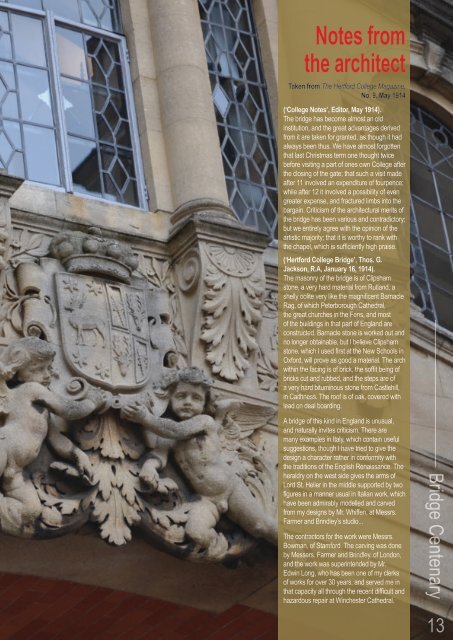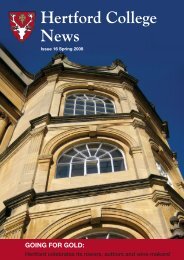Issue 24 - Hertford College - University of Oxford
Issue 24 - Hertford College - University of Oxford
Issue 24 - Hertford College - University of Oxford
- No tags were found...
You also want an ePaper? Increase the reach of your titles
YUMPU automatically turns print PDFs into web optimized ePapers that Google loves.
Notes from<br />
the architect<br />
Taken from The <strong>Hertford</strong> <strong>College</strong> Magazine,<br />
No. 9. May 1914<br />
(‘<strong>College</strong> Notes’, Editor, May 1914).<br />
The bridge has become almost an old<br />
institution, and the great advantages derived<br />
from it are taken for granted, as though it had<br />
always been thus. We have almost forgotten<br />
that last Christmas term one thought twice<br />
before visiting a part <strong>of</strong> ones own <strong>College</strong> after<br />
the closing <strong>of</strong> the gate; that such a visit made<br />
after 11 involved an expenditure <strong>of</strong> fourpence;<br />
while after 12 it involved a possibility <strong>of</strong> even<br />
greater expense, and fractured limbs into the<br />
bargain. Criticism <strong>of</strong> the architectural merits <strong>of</strong><br />
the bridge has been various and contradictory;<br />
but we entirely agree with the opinion <strong>of</strong> the<br />
artistic majority; that it is worthy to rank with<br />
the chapel, which is sufficiently high praise.<br />
(‘<strong>Hertford</strong> <strong>College</strong> Bridge’, Thos. G.<br />
Jackson, R.A, January 16, 1914).<br />
The masonry <strong>of</strong> the bridge is <strong>of</strong> Clipsham<br />
stone, a very hard material from Rutland, a<br />
shelly oolite very like the magnificent Barnacle<br />
Rag, <strong>of</strong> which Peterborough Cathedral,<br />
the great churches in the Fens, and most<br />
<strong>of</strong> the buildings in that part <strong>of</strong> England are<br />
constructed. Barnacle stone is worked out and<br />
no longer obtainable, but I believe Clipsham<br />
stone, which I used first at the New Schools in<br />
<strong>Oxford</strong>, will prove as good a material. The arch<br />
within the facing is <strong>of</strong> brick, the s<strong>of</strong>fit being <strong>of</strong><br />
bricks cut and rubbed, and the steps are <strong>of</strong><br />
a very hard bituminous stone from Castlehill,<br />
in Caithness. The ro<strong>of</strong> is <strong>of</strong> oak, covered with<br />
lead on deal boarding.<br />
A bridge <strong>of</strong> this kind in England is unusual,<br />
and naturally invites criticism. There are<br />
many examples in Italy, which contain useful<br />
suggestions, though I have tried to give the<br />
design a character rather in conformity with<br />
the traditions <strong>of</strong> the English Renaissance. The<br />
heraldry on the west side gives the arms <strong>of</strong><br />
Lord St. Helier in the middle supported by two<br />
figures in a manner usual in Italian work, which<br />
have been admirably modelled and carved<br />
from my designs by Mr. Whiffen, at Messrs.<br />
Farmer and Brindley’s studio...<br />
The contractors for the work were Messrs.<br />
Bowman, <strong>of</strong> Stamford. The carving was done<br />
by Messers. Farmer and Brindley, <strong>of</strong> London,<br />
and the work was superintended by Mr.<br />
Edwin Long, who has been one <strong>of</strong> my clerks<br />
<strong>of</strong> works for over 30 years, and served me in<br />
that capacity all through the recent difficult and<br />
hazardous repair at Winchester Cathedral.<br />
Bridge Centenary<br />
13




